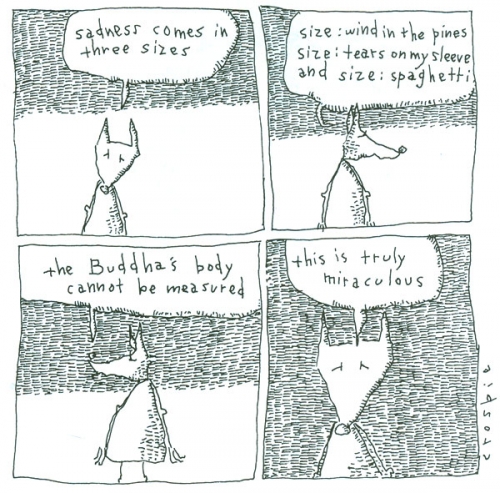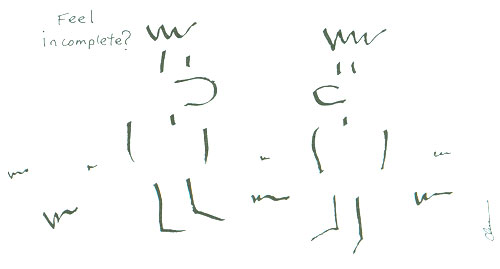Tricycle welcomes letters to the editor. Letters are subject to editing. Please send correspondence to:
Tricycle: The Buddhist Review
92 Vandam St.
New York, NY 10013
Fax: (212) 645-1493
E-mail address: editorial@tricycle.com
Dharma Mums
I read Anne Cushman’s article on parenting and practice (Fall 2001) twice, so hungry have I been for words on this subject. Some months ago, while driving my son to preschool, I was preoccupied with thoughts of my parents, both of whom had recently been diagnosed with cancer. From the back seat, my son suddenly said, “It’s a beautiful day, isn’t it, Mama?” He presents me with so many challenges, as well as opportunities to choose my actions with care. I actually began to sit after I had children, not before, and I no longer question whether mothering and practice are compatible.
—Luann Rouff
E-mail
“Mothering as Meditation Practice” is a fabulous blend of wit and realism. My husband and I have searched for role models, articles, books, and, of course, people to help with the dissonance we have felt regarding the integration of parenthood and our Buddhist lifestyle. Unfortunately, there is little information out there. How do we incorporate the individualist models of Buddhist tradition into our new family life? Does becoming a mother mean that I have to stop my meditative development? The Cushman piece did a lovely job of connecting to the mothering spirit while staying true to Buddhist perspectives.
—Joellyn Johnson
Bozeman, MT
A Queer View
Bravo for Lama Sarah Harding’s prescient and far-reaching vision of the future of American Buddhism (Fall 2001). As a queer Buddhist, I was especially grateful for her words on gay, lesbian, bisexual, and transgender practitioners. While others debate our place in Buddhism from an assumed position of privilege, Harding takes an inspiring lead in pointing out what we offer Buddhism by our challenge to the seemingly unassailable duality of male/female. The queer position refutes essentialism and dualistic thinking, and as such is well aligned with Buddhist understanding.
I applaud Harding’s courage, leadership, and vision.
—Anne Blazing
E-mail
Huston, We’ve Got A Problem
In response to Huston Smith’s treatise on spirituality versus religion (Fall 2001), I agree that religion has certainly gotten “traction in history.” This stems from the tendency of religion to focus on who’s right and who’s wrong; whose God is the God; who the Chosen are; and which group God gives us the authority to annihilate.
On the other hand, spirituality is nonjudgmental, non-attached, open to all, does no harm, and promotes a sense of self as connected to the whole. I have the utmost respect for organized religion and the positive contributions it makes to people’s lives. However, there is most definitely a difference between spirituality and religion. Although spiritual people can be also religious people, and vice versa, most religions promote their own agenda rather than the spiritual development of the individual. Religion will continue to shape history, but it is spirituality that will shape souls. Only in this way can we write a history of love, not death and destruction, in the name of God.
—Clare Goldsberry
Phoenix, AZ

United Nations of Buddhism
I found Richard Seager’s piece on Soka Gakkai very illuminating. As a middle-class, white, well-educated American Buddhist, it made me aware of many of my own prejudices toward Soka Gakkai, and I am grateful for Seager’s clarification. In contrast to Soka Gakkai, the Buddhism that I practice has been accused of being racist, elitist, classist, and, as Seager reminds us, of being for intellectuals only. Sokai Gakkai, according to Seager, communicates that Buddhism is not just for intellectuals.
Seager speaks of bridging a “practice gap” and suggests that a greater understanding of the interdependence of all kinds of Buddhism would serve us well. Yes, for those of us who wish to join the politically correct United Nations of Buddhism. I, for one, do not. There is a place for tolerance, mutual respect, and diversity, as well as for understanding the sociological components of religion. But Seager’s argument for bridging racial divides and practice gaps to more accurately reflect an American Buddhism smacks of liberal colonialism. The real struggle for Buddhists in this country is not how to mix up all our practices and have racially diversified sanghas (which was mentioned in several other essays in the section). The real struggle in this country is, and will be, to maintain the value of practices that have a cutting-edge; transformative practices that are rough-going, ego-killing, counter-intuitive, and demanding. Practices that push us into places that we don’t want to go and can’t control, and that make us quake with anxiety – practices that have nothing to do with social issues.
Having said that, congratulations to Tricycle on turning ten. The interview with Helen Tworkov gave me a real appreciation for the ways the magazine has been walking a tightrope over very thorny terrain. I also think, regarding my disagreement with Seager, that the magazine has done a fine job of allowing many different practices to have their own integrity within a non-sectarian magazine, and of encouraging readers to think for themselves by allowing so many contradictory views. I look forward to the next ten years.
—Brad Linton
E-mail
Opening the umbrella
I enjoyed Richard Seager’s article on Soka Gakkai (Fall 2001). However, at the beginning of his article, Mr. Seager makes a serious error: Nichiren Shoshu in Japan is not and never was “an umbrella school comprising some forty sects dedicated to the teachings of Nichiren.” The umbrella school was called Nichiren Shu, which, at the outbreak of World War II, consisted of about 4,000 temples. Dissident minority sects were permitted to form new federations of their own provided they met certain criteria. Nichiren Shoshu insisted it was the only true Nichiren sect, but the government declared that it was too small to exist as a separate body. Determined to maintain their independence, the ruling clergy of Nichiren Shoshu developed a stratagem to prove their loyalty to the imperial government, and Nichiren Shoshu was permitted to continue existing independently. Makiguchi, the founder of Soka Gakkai, and his assistant, Toda, refused to obey this order and two days later were incarcerated. Makiguchi died in prison. Toda survived and emerged to rebuild the ruined Soka Gakkai into the important organization it is today.
—Daniel B. Montgomery
Kerrville, TX
Porterfield Responds
Unfortunately, Sarah Sloane did not give an accurate account of my book, The Transformation of American Religion, in her review (Fall 2001). The book does not “ascrib[e] Buddhist ideas of compassion to an influx of Jewish practitioners,” as she alleges. Instead, it argues that Americans with Jewish backgrounds have made significant contributions to the development of Buddhism in the U.S. because Buddhism engages concerns about suffering that are at the heart of Jewish identity and resonate powerfully with traditional Jewish respect for human decency.
While I am honored to have my book reviewed along with Diana Eck’s A New Religious America, and believe that our books do complement each other, it is misleading to say, as Prof. Sloane does, that we are “tackling the same question.” Eck’s book maps the diversity of religious institutions in the United States. Mine has little to do with religious institutions. Rather, it is a historical work that explores how Buddhism (among other things) contributed to a momentous shift in underlying cultural attitudes toward religion in the United States, attitudes that have been shaped over several centuries by Protestant individualism.
—Amanda Porterfield
E-mail

Dharma Publishing
We are writing to correct one error in your interesting timeline, “Moments in American Buddhism” (Fall 2001), that may mislead readers. Dharma Publishing was founded in Berkeley, California, not in Boston, as you indicate. In itself, the geography may not matter, but the mistake obscures the fact that Dharma Publishing was founded by the Nyingma lama Tarthang Tulku, who took up residence in Berkeley in 1969, as you correctly note. Tarthang Tulku continues to guide Dharma Publishing and to shape its vision for the preservation of the dharma and its transmission to the West.
—Jack Petranker and Betty Cook
Berkeley, CA
The Wild World of Zen
Congratulations on your beautiful tenth anniversary issue! It was filled with wonderful material and, while my complaint regarding one particular essay did little to reduce my general enjoyment, I cannot help but register it.
Sallie Tisdale does a fine job describing the maturing of Zen in the United States (Fall 2001), and she raises many important issues. Yet, while “getting stuck in emptiness” is the ancient Zen sickness, the imbalance can go the other way as well. I am not unaware of the needs for health insurance or childcare. But it seems a shame to have denied your readership even a glimpse into the zany, wild, and weird world of Zen where, within in its unknown dimensions and vast spaciousness, even the pedestrian forms of the householder can be borne with a little levity.
—Linda Goldstein
E-mail
Incorporating the Dharma
In his article “Who’s Zoomin’ Who? The Commodification of Buddhism in the American Marketplace” (Summer 2001), David Patt quotes Marx in pointing out that one of the most pernicious aspects of capitalism is its ability to commodify even cultural and religious values. To see a textbook example of this, one need look no further than the interview with Mirabai Bush, “Contemplating Corporate Culture,” also in the Summer 2001 issue.
Ms. Bush and others think that bringing contemplation (Buddhist-style) into the inner sanctum of American power will humanize its corporate institutions. Ms. Bush denied the interviewer’s propositions that the corporations had a “particular genius . . . to turn anything and everything into a marketing coup” and that she might simply be “helping them to package themselves as nice guys.” She denied these suggestions despite the considerable literature documenting the historical success of capitalist institutions to engulf, absorb, and neutralize those very ideas and forces that would alter their singular pursuit for profit. Ms. Bush is obviously a compassionate and bright person. But is she also exhibiting naive utopianism? The idea that the barons of U.S. industry will make a better workplace, think more contemplatively, and make better products (weapons?) through Buddhist thought is remarkable. If the renunciation of wordly attachments is central to all Buddhist thought, and capitalism is the commodification of attachments, Ms. Bush’s project may prove to be an example of “the intoxicating effect of the marketplace” that Patt is warning against.
—Carey Linde
Vancouver, BC
Author’s Correction
An editorial error appeared in the subhead of my essay “Zen and Then” (Fall 2001), where I was identified as a Zen priest. I am not a priest, but a lay teacher. In my lineage, a priest must be a monk, and his or her life is lived in service to the sangha, free of family and job responsibilities. A lay teacher serves as a model of mature practice in the world, often within those responsibilities. There is a particular irony in this mistake, as one of the points with which I was concerned is the murky definition of the priesthood in American Zen and the blurring of lay and monastic forms. I think many of us still carry the idea (however subtle) that there is something “higher” in the priestly role. I support the development of an authorized lay teacher rank as a way of honoring the myriad expressions of dharma. I apologize for any misunderstanding.
—Sallie Jiko Tisdale
E-mail ▼